Immigrants and the Obstruction of Language: A Literature Review
VerifiedAdded on 2022/08/12
|6
|1155
|25
Report
AI Summary
This report provides a literature review on the challenges immigrants face in acquiring the English language. It begins with an introduction to the concept of migration and its impact, followed by a discussion on the meaning of immigrants and the importance of language in cultural contexts. The core of the report examines the specific obstacles immigrants encounter, such as cultural differences and the need for seamless communication, which hinders their integration and quality of life. The analysis draws on various sources to highlight how language barriers affect employment, social interaction, and overall well-being. The conclusion summarizes the key findings, emphasizing the role of cultural integration and the vicious cycle immigrants often experience due to language difficulties. The report underscores the need for understanding and support to help immigrants overcome these challenges and successfully integrate into their new societies. This document is available on Desklib, a platform providing AI-based study tools for students.
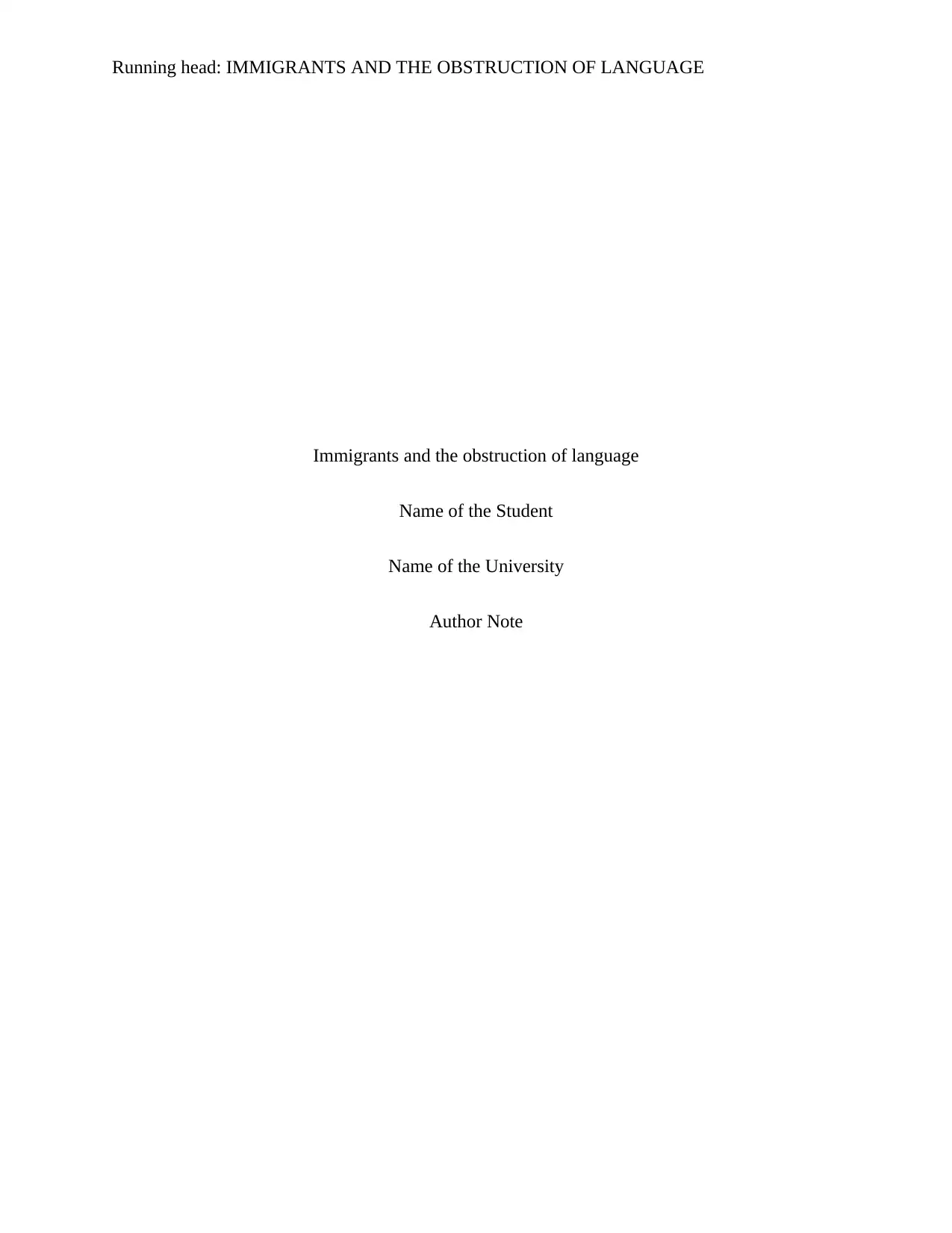
Running head: IMMIGRANTS AND THE OBSTRUCTION OF LANGUAGE
Immigrants and the obstruction of language
Name of the Student
Name of the University
Author Note
Immigrants and the obstruction of language
Name of the Student
Name of the University
Author Note
Paraphrase This Document
Need a fresh take? Get an instant paraphrase of this document with our AI Paraphraser
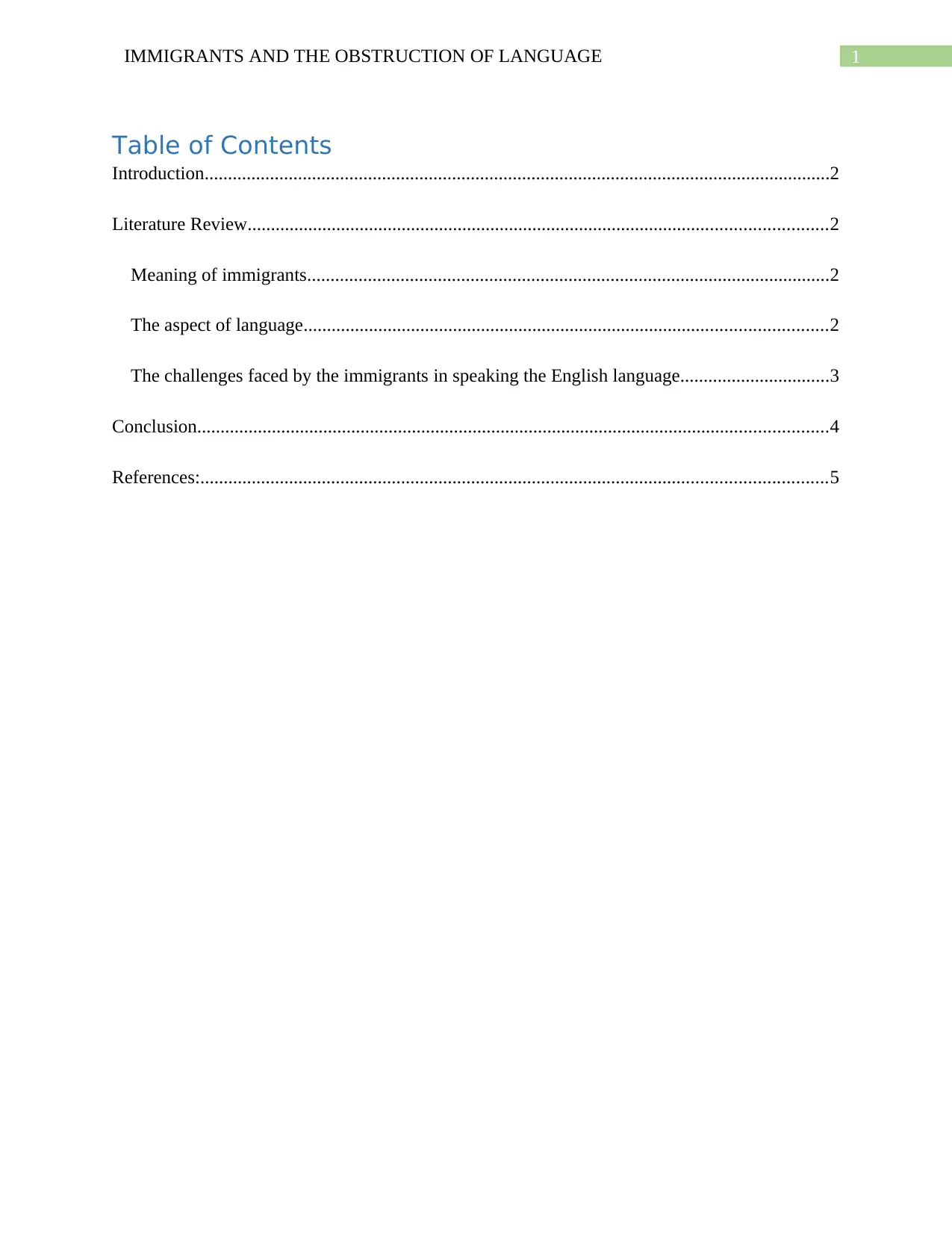
1IMMIGRANTS AND THE OBSTRUCTION OF LANGUAGE
Table of Contents
Introduction......................................................................................................................................2
Literature Review............................................................................................................................2
Meaning of immigrants................................................................................................................2
The aspect of language................................................................................................................2
The challenges faced by the immigrants in speaking the English language................................3
Conclusion.......................................................................................................................................4
References:......................................................................................................................................5
Table of Contents
Introduction......................................................................................................................................2
Literature Review............................................................................................................................2
Meaning of immigrants................................................................................................................2
The aspect of language................................................................................................................2
The challenges faced by the immigrants in speaking the English language................................3
Conclusion.......................................................................................................................................4
References:......................................................................................................................................5
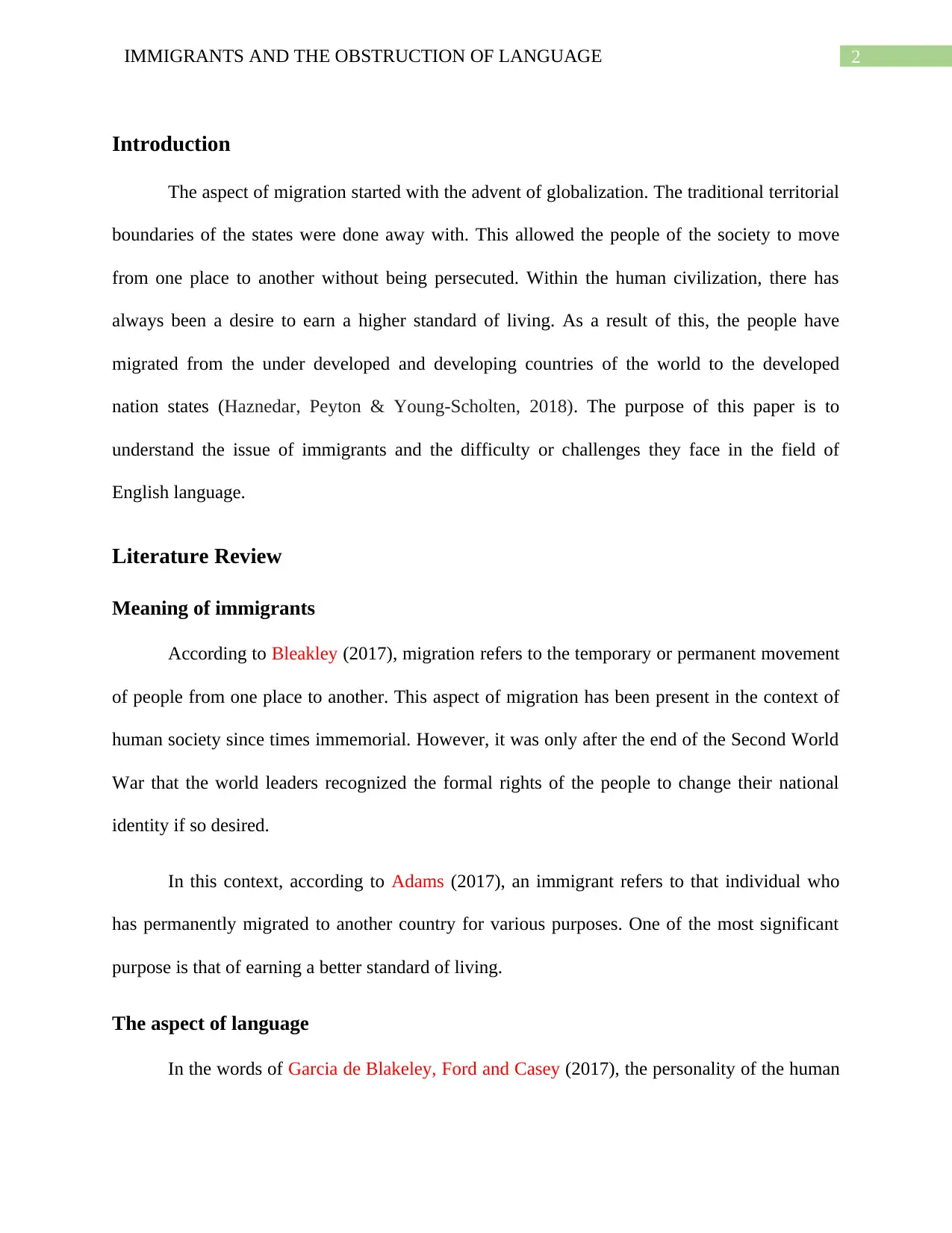
2IMMIGRANTS AND THE OBSTRUCTION OF LANGUAGE
Introduction
The aspect of migration started with the advent of globalization. The traditional territorial
boundaries of the states were done away with. This allowed the people of the society to move
from one place to another without being persecuted. Within the human civilization, there has
always been a desire to earn a higher standard of living. As a result of this, the people have
migrated from the under developed and developing countries of the world to the developed
nation states (Haznedar, Peyton & Young-Scholten, 2018). The purpose of this paper is to
understand the issue of immigrants and the difficulty or challenges they face in the field of
English language.
Literature Review
Meaning of immigrants
According to Bleakley (2017), migration refers to the temporary or permanent movement
of people from one place to another. This aspect of migration has been present in the context of
human society since times immemorial. However, it was only after the end of the Second World
War that the world leaders recognized the formal rights of the people to change their national
identity if so desired.
In this context, according to Adams (2017), an immigrant refers to that individual who
has permanently migrated to another country for various purposes. One of the most significant
purpose is that of earning a better standard of living.
The aspect of language
In the words of Garcia de Blakeley, Ford and Casey (2017), the personality of the human
Introduction
The aspect of migration started with the advent of globalization. The traditional territorial
boundaries of the states were done away with. This allowed the people of the society to move
from one place to another without being persecuted. Within the human civilization, there has
always been a desire to earn a higher standard of living. As a result of this, the people have
migrated from the under developed and developing countries of the world to the developed
nation states (Haznedar, Peyton & Young-Scholten, 2018). The purpose of this paper is to
understand the issue of immigrants and the difficulty or challenges they face in the field of
English language.
Literature Review
Meaning of immigrants
According to Bleakley (2017), migration refers to the temporary or permanent movement
of people from one place to another. This aspect of migration has been present in the context of
human society since times immemorial. However, it was only after the end of the Second World
War that the world leaders recognized the formal rights of the people to change their national
identity if so desired.
In this context, according to Adams (2017), an immigrant refers to that individual who
has permanently migrated to another country for various purposes. One of the most significant
purpose is that of earning a better standard of living.
The aspect of language
In the words of Garcia de Blakeley, Ford and Casey (2017), the personality of the human
⊘ This is a preview!⊘
Do you want full access?
Subscribe today to unlock all pages.

Trusted by 1+ million students worldwide
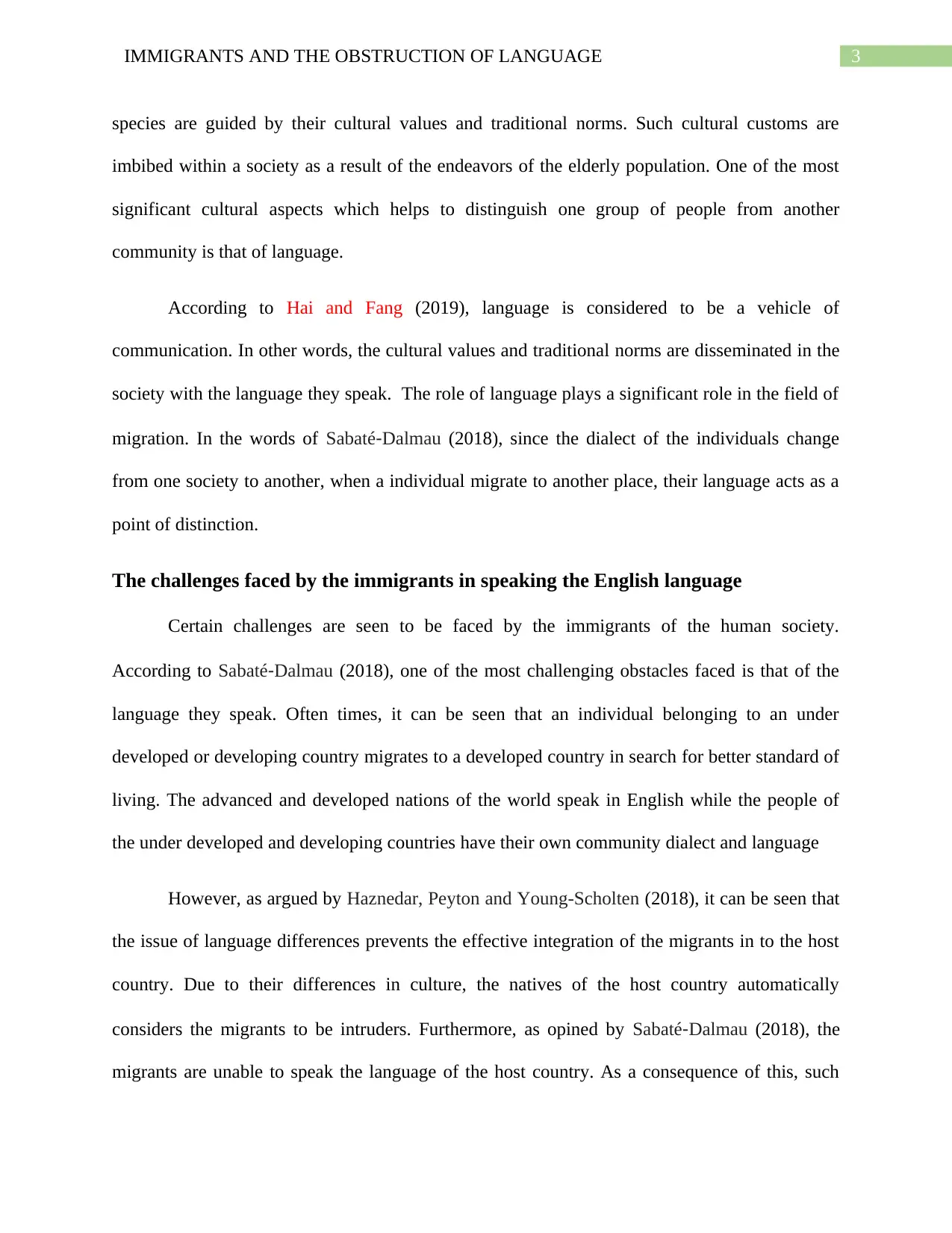
3IMMIGRANTS AND THE OBSTRUCTION OF LANGUAGE
species are guided by their cultural values and traditional norms. Such cultural customs are
imbibed within a society as a result of the endeavors of the elderly population. One of the most
significant cultural aspects which helps to distinguish one group of people from another
community is that of language.
According to Hai and Fang (2019), language is considered to be a vehicle of
communication. In other words, the cultural values and traditional norms are disseminated in the
society with the language they speak. The role of language plays a significant role in the field of
migration. In the words of Sabaté‐Dalmau (2018), since the dialect of the individuals change
from one society to another, when a individual migrate to another place, their language acts as a
point of distinction.
The challenges faced by the immigrants in speaking the English language
Certain challenges are seen to be faced by the immigrants of the human society.
According to Sabaté‐Dalmau (2018), one of the most challenging obstacles faced is that of the
language they speak. Often times, it can be seen that an individual belonging to an under
developed or developing country migrates to a developed country in search for better standard of
living. The advanced and developed nations of the world speak in English while the people of
the under developed and developing countries have their own community dialect and language
However, as argued by Haznedar, Peyton and Young-Scholten (2018), it can be seen that
the issue of language differences prevents the effective integration of the migrants in to the host
country. Due to their differences in culture, the natives of the host country automatically
considers the migrants to be intruders. Furthermore, as opined by Sabaté‐Dalmau (2018), the
migrants are unable to speak the language of the host country. As a consequence of this, such
species are guided by their cultural values and traditional norms. Such cultural customs are
imbibed within a society as a result of the endeavors of the elderly population. One of the most
significant cultural aspects which helps to distinguish one group of people from another
community is that of language.
According to Hai and Fang (2019), language is considered to be a vehicle of
communication. In other words, the cultural values and traditional norms are disseminated in the
society with the language they speak. The role of language plays a significant role in the field of
migration. In the words of Sabaté‐Dalmau (2018), since the dialect of the individuals change
from one society to another, when a individual migrate to another place, their language acts as a
point of distinction.
The challenges faced by the immigrants in speaking the English language
Certain challenges are seen to be faced by the immigrants of the human society.
According to Sabaté‐Dalmau (2018), one of the most challenging obstacles faced is that of the
language they speak. Often times, it can be seen that an individual belonging to an under
developed or developing country migrates to a developed country in search for better standard of
living. The advanced and developed nations of the world speak in English while the people of
the under developed and developing countries have their own community dialect and language
However, as argued by Haznedar, Peyton and Young-Scholten (2018), it can be seen that
the issue of language differences prevents the effective integration of the migrants in to the host
country. Due to their differences in culture, the natives of the host country automatically
considers the migrants to be intruders. Furthermore, as opined by Sabaté‐Dalmau (2018), the
migrants are unable to speak the language of the host country. As a consequence of this, such
Paraphrase This Document
Need a fresh take? Get an instant paraphrase of this document with our AI Paraphraser
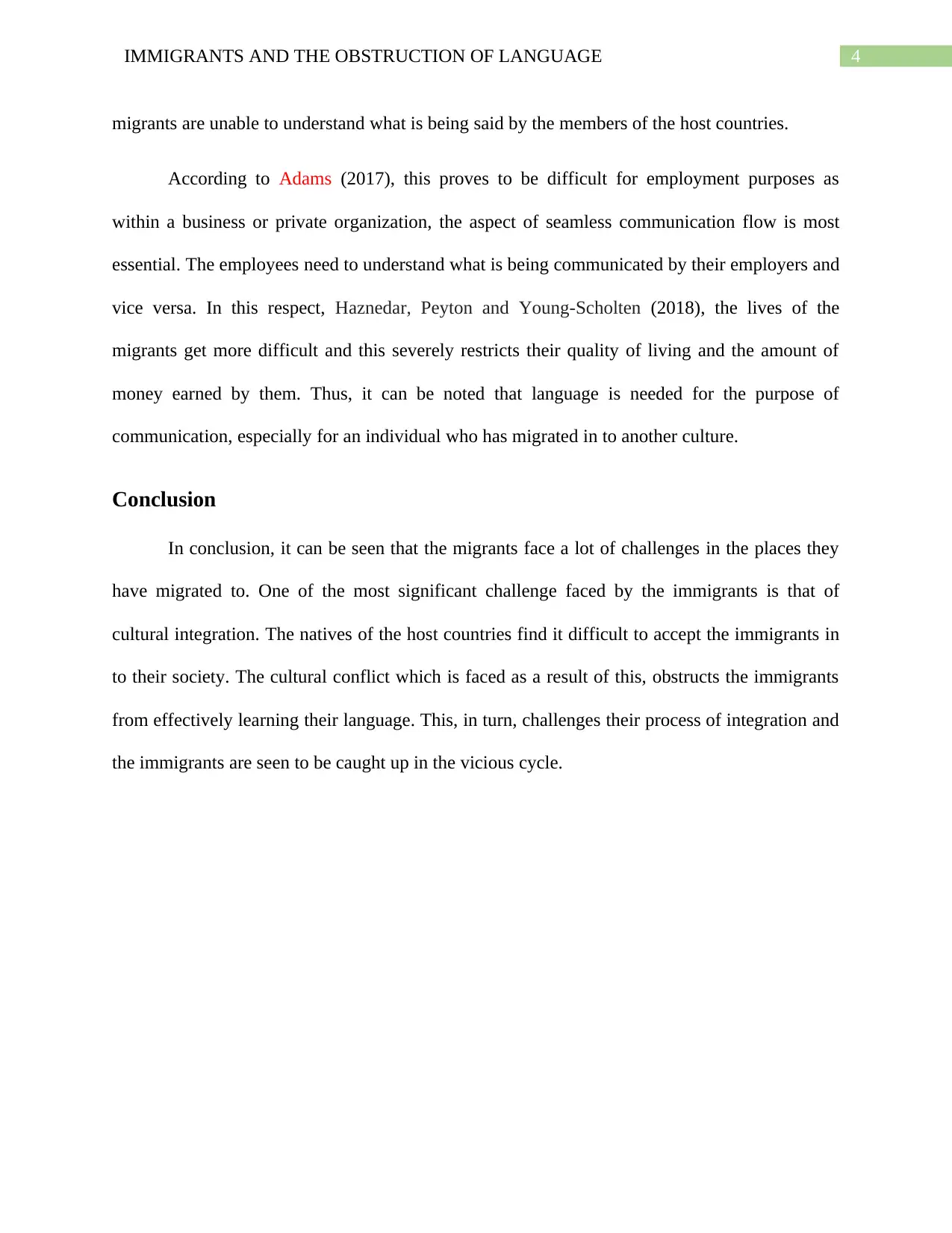
4IMMIGRANTS AND THE OBSTRUCTION OF LANGUAGE
migrants are unable to understand what is being said by the members of the host countries.
According to Adams (2017), this proves to be difficult for employment purposes as
within a business or private organization, the aspect of seamless communication flow is most
essential. The employees need to understand what is being communicated by their employers and
vice versa. In this respect, Haznedar, Peyton and Young-Scholten (2018), the lives of the
migrants get more difficult and this severely restricts their quality of living and the amount of
money earned by them. Thus, it can be noted that language is needed for the purpose of
communication, especially for an individual who has migrated in to another culture.
Conclusion
In conclusion, it can be seen that the migrants face a lot of challenges in the places they
have migrated to. One of the most significant challenge faced by the immigrants is that of
cultural integration. The natives of the host countries find it difficult to accept the immigrants in
to their society. The cultural conflict which is faced as a result of this, obstructs the immigrants
from effectively learning their language. This, in turn, challenges their process of integration and
the immigrants are seen to be caught up in the vicious cycle.
migrants are unable to understand what is being said by the members of the host countries.
According to Adams (2017), this proves to be difficult for employment purposes as
within a business or private organization, the aspect of seamless communication flow is most
essential. The employees need to understand what is being communicated by their employers and
vice versa. In this respect, Haznedar, Peyton and Young-Scholten (2018), the lives of the
migrants get more difficult and this severely restricts their quality of living and the amount of
money earned by them. Thus, it can be noted that language is needed for the purpose of
communication, especially for an individual who has migrated in to another culture.
Conclusion
In conclusion, it can be seen that the migrants face a lot of challenges in the places they
have migrated to. One of the most significant challenge faced by the immigrants is that of
cultural integration. The natives of the host countries find it difficult to accept the immigrants in
to their society. The cultural conflict which is faced as a result of this, obstructs the immigrants
from effectively learning their language. This, in turn, challenges their process of integration and
the immigrants are seen to be caught up in the vicious cycle.
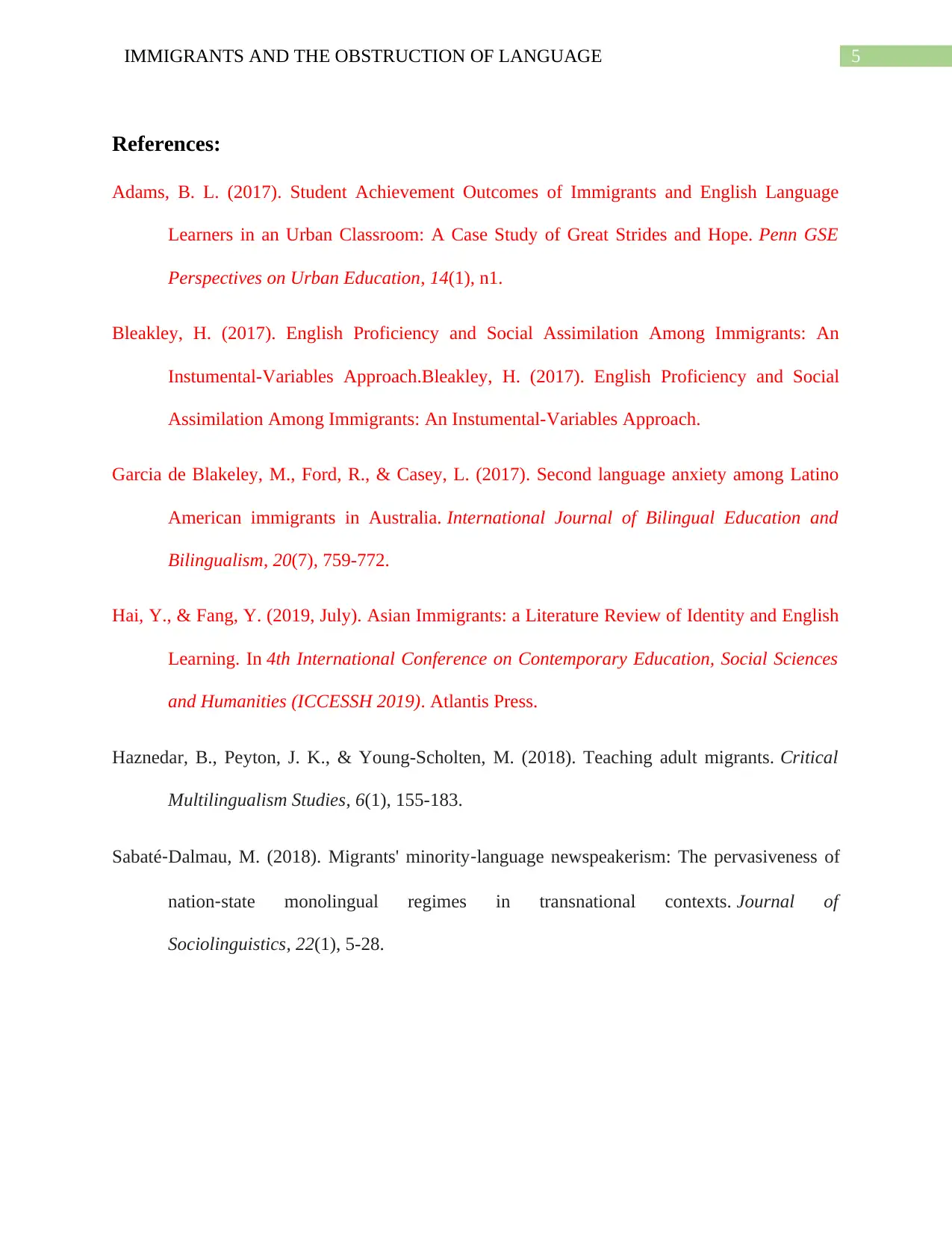
5IMMIGRANTS AND THE OBSTRUCTION OF LANGUAGE
References:
Adams, B. L. (2017). Student Achievement Outcomes of Immigrants and English Language
Learners in an Urban Classroom: A Case Study of Great Strides and Hope. Penn GSE
Perspectives on Urban Education, 14(1), n1.
Bleakley, H. (2017). English Proficiency and Social Assimilation Among Immigrants: An
Instumental-Variables Approach.Bleakley, H. (2017). English Proficiency and Social
Assimilation Among Immigrants: An Instumental-Variables Approach.
Garcia de Blakeley, M., Ford, R., & Casey, L. (2017). Second language anxiety among Latino
American immigrants in Australia. International Journal of Bilingual Education and
Bilingualism, 20(7), 759-772.
Hai, Y., & Fang, Y. (2019, July). Asian Immigrants: a Literature Review of Identity and English
Learning. In 4th International Conference on Contemporary Education, Social Sciences
and Humanities (ICCESSH 2019). Atlantis Press.
Haznedar, B., Peyton, J. K., & Young-Scholten, M. (2018). Teaching adult migrants. Critical
Multilingualism Studies, 6(1), 155-183.
Sabaté‐Dalmau, M. (2018). Migrants' minority‐language newspeakerism: The pervasiveness of
nation‐state monolingual regimes in transnational contexts. Journal of
Sociolinguistics, 22(1), 5-28.
References:
Adams, B. L. (2017). Student Achievement Outcomes of Immigrants and English Language
Learners in an Urban Classroom: A Case Study of Great Strides and Hope. Penn GSE
Perspectives on Urban Education, 14(1), n1.
Bleakley, H. (2017). English Proficiency and Social Assimilation Among Immigrants: An
Instumental-Variables Approach.Bleakley, H. (2017). English Proficiency and Social
Assimilation Among Immigrants: An Instumental-Variables Approach.
Garcia de Blakeley, M., Ford, R., & Casey, L. (2017). Second language anxiety among Latino
American immigrants in Australia. International Journal of Bilingual Education and
Bilingualism, 20(7), 759-772.
Hai, Y., & Fang, Y. (2019, July). Asian Immigrants: a Literature Review of Identity and English
Learning. In 4th International Conference on Contemporary Education, Social Sciences
and Humanities (ICCESSH 2019). Atlantis Press.
Haznedar, B., Peyton, J. K., & Young-Scholten, M. (2018). Teaching adult migrants. Critical
Multilingualism Studies, 6(1), 155-183.
Sabaté‐Dalmau, M. (2018). Migrants' minority‐language newspeakerism: The pervasiveness of
nation‐state monolingual regimes in transnational contexts. Journal of
Sociolinguistics, 22(1), 5-28.
⊘ This is a preview!⊘
Do you want full access?
Subscribe today to unlock all pages.

Trusted by 1+ million students worldwide
1 out of 6
Related Documents
Your All-in-One AI-Powered Toolkit for Academic Success.
+13062052269
info@desklib.com
Available 24*7 on WhatsApp / Email
![[object Object]](/_next/static/media/star-bottom.7253800d.svg)
Unlock your academic potential
Copyright © 2020–2025 A2Z Services. All Rights Reserved. Developed and managed by ZUCOL.




